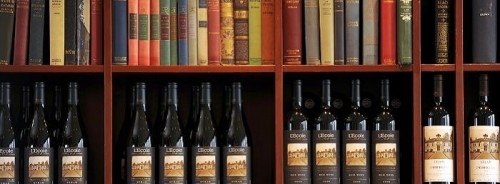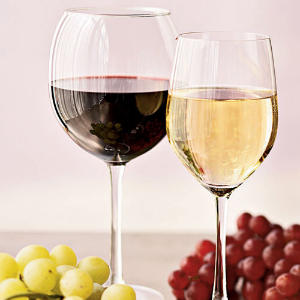
The world of wine is as vast as the world of books. For those more familiar with books than wine, here’s a quick run down of the basics.

Red wine vs. White wine:
The differences between red wines and white wines are pretty obvious; they look different and taste different, and are often described using a completely separate vocabulary. By why are they so drastically different? They are both made from grapes, right? Well, here’s the culprit: the skins. The skins bring a lot to the mix, primarily tannins.
In short, tannins are a naturally occurring substance in grapes and other fruits that has a flavor often described as a bitter taste, causing a dry and puckery feeling in the mouth. Tannins end up in your wine when the vintner allows the skins to sit in the grape juice as it ferments. This is also how wine gets its color! So that’s the short story: red wines are often fermented with the skins for longer than pink or white, which is why they tend to have higher tannin content.

Tannin is the basis of red wine. In general, the darker the wine, the higher the tannin content or “bolder†the taste. Red wines are frequently described as “thickerâ€, “leathery†or “bitter†depending on the amount of tannin present.
Popular red wine varietals:Â Cabernet Sauvignon, Zinfandel, Merlot, Pinot Noir, Cabernet Franc, Malbec, Barbera, Sangiovese
White wine has tannin, but not as much as red. What sticks out more in white wines is acidity. That’s what brings words like “crisp†or “tart†to the table when you open a bottle.
Popular white wine varietals: Chardonnay, Riesling, Sauvignon Blanc, Semillon, Moscato (Muscat), Pinot Grigio, Gewürztraminer
Rose, or blush wine, is pink in color. This is because it’s time with the skins is limited compared to red wine. Between red and white wines, rose is closer to white as it is still on the low end of the tannin spectrum.
Popular rosé wine varietals: Pinot Noir, Zinfandel, Pinot Grigio, Sangiovese
Next on the list is Dessert wine and Sparkling wine (or bubbles).

Dessert wine is just as it sounds…frequently enjoyed after a meal for dessert. Yum! It’s often sweeter and higher in alcohol content. The alcohol is usually added to help the drink retain more of the natural sugars that are usually used up during the fermentation process.
Popular dessert wines/fortified wines:Â Port, Madeira, Vermouth, Sherry, Marsala
Sparkling wine is wine that has carbonation. This comes from either the natural fermentation process or via carbonation injection after the fact. Either way, it’s adds a certain amount of fun to the drink! When looking for a sparkling wine, consider the terms listed on the bottle that indicate how sweet or dry it is.
From driest to sweetest, these terms are:Â Brut Nature, Extra Brut, Brut, Extra Dry/Extra Sec/Extra Seco, Dry/Sec/Seco, Demi-Sec/Semi-seco and Doux/Sweet/Dulce

So, in readers’ speak, how can I sum this up? Red wine is Bram Stroker’s Dracula and white is Twilight. Dracula is a dark, heavy classic, digging into the depths of vampirism and what it does to a man’s life. Twilight is instantly accessible, focuses more on the young, romantic edge and is a lighter read.
Dessert wine could be considered the Shopaholic series of the wine world. Lighter, fun and, in a way, dangerous in that the sweetness often conceals the alcohol content. Just like a beach read, you’ll start out happy and unassuming and before you know it your head is swirling as you turn the page to chapter 15.
Sparking wine is the Great Gatsby of the party. Effervescent and airy, the classy bubbly. One could imagine Gatsby, with some champagne, looking down on one of his lavish parties watching his guests bubbling like the Brut in his glass.
So that’s a brief summery of wine in all its forms. Drink well, friends, and be inspired. Cheers!



